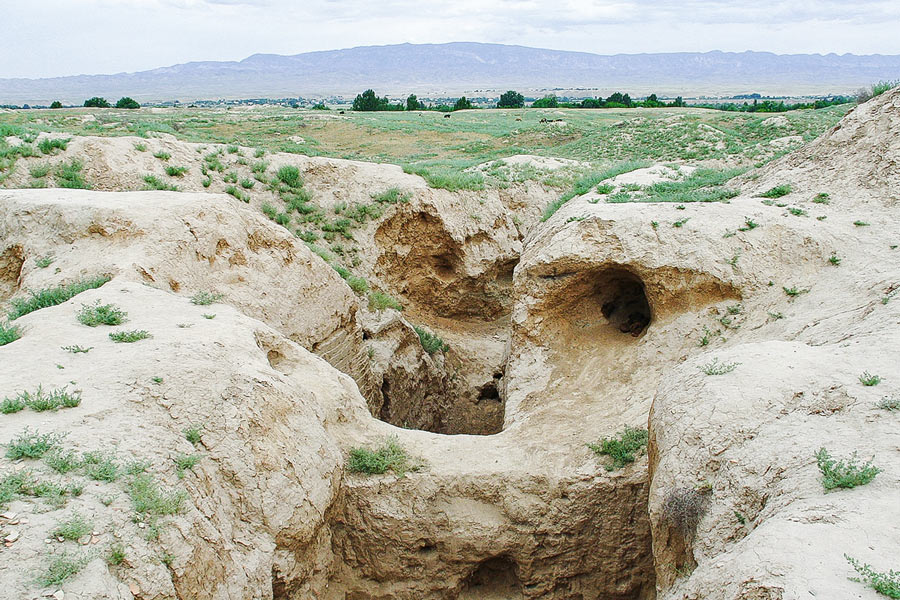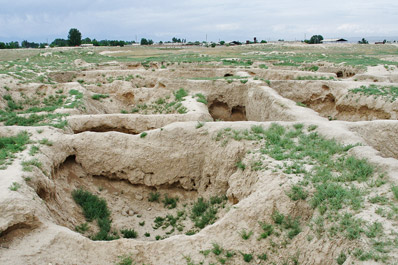Dalverzin-Tepa, vicinity of Termez

The dynamic of formation and development of Kushan city was investigated in the northern Bactria at the example of Dalverzin-Tepa (40 kms away from Khalchayan). The settlement was situated in a valley of the Surkhan Darya river on the bank of Karmakisai 7 km northward from Shurchi, a modern regional center. The initial settlement arose at the southern part a sand plateau in the 3rd-2nd cc. B.C. Probably, the wall dated from Greco-Bactrian time surrounded the settlement being already generated, that determined external contours of it - polyhedron of 170-200 m in diameter.
To the north developed fortified settlement of dispersed layout. Supposedly, at the second half of the 1st century B.C. or at the beginning of the 1st century A.D. on a place of initial core was formed a citadel with powerful walls of 7 m in width being surrounded by moat. Ordinary settlement was transformed into a city that occupied a rectangular site surrounded by walls around the perimeter. The city survived through its blossoming in the 1st - first half of the 3rd cc. A.D. It had regular dwelling area, which included the quarters of ordinary and rich people. At this time there were temples of different religions: in a city center was settled down Buddhist temple, at the northern wall - the temple of a local goddess.
A quarter of potters occupied the southwestern corner. In the northern district was remained Zoroastrinian naus. Besides that, was excavated Buddhist sanctuary dated back to the time of Vima Kadphises (the second half of the 1st century A.D.). The "House of symbol" and "House of an image" is supposed to occupy the same room. A circular corridor surrounded three sides of a rectangular platform, probably, being a basis of a mortal imitating tower. The northern part was a place for burning fires before the statue of Buddha being accompanied by geniuses and devats.
Considering the sculpture composition, the eastern, the most spacious part could be a hall for glorification of Kushan tsars. To the south were located isolated rooms and structures being connected with the hostel of monks serving the temple. Huge suburbs were in the process of formation. On the one hand, there concentrated cult and memorial buildings, and on the other hand - cultivated lands. In the best its period Dalverzin-Tepa and its suburbs occupied about 50 hectares. From that moment, the initial city began to play a role of citadel. Pugachenkova G.A. considers Dalverzin to be a dynastic capital of Khodzo Kushans, being mentioned in the sources. It is supposed, that the city would include more than 300 estates. It is possible, that some quarters were incorporated in structural units being similar to medieval "da-khya".
The excavations revealed four small areas of 0,3-0,4 hectares being occupied by dwelling houses and streets, which could prove the existence of four sectors in shahristan of Dalverzin-Tepa. The separate quarter made a living complex in the southern part of a city. It consisted of dwelling houses, temple, pottery workshops and courtyard. Probably, each urban section had own temple and water reservoir. The city, probably, was destroyed in the second half of the 3rd century A.D. at a result of Sasanian campaigns or/and according to the latest data, at a result of powerful flood washing off a part of fortification system in the southeastern sector of a city. In the 6th-7th cc. A.D. occurred temporary arise of the citadel, but it was then not fortified settlement. Graves nearby city walls could be related to the same time.
The multimedia-encyclopedia "TERMEZ-2500"
More useful links:



